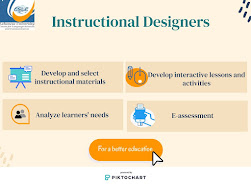Introducing Instructional Design
Have you ever wondered what do we mean by Instructional Design? This new term has been used lately post Covid-19 as educational institutions switched from face-to-face learning into distant(online) learning.
Instructional design is defined as the design of learning experiences. The material designed has to be effective, efficient, and appealing to the learners.
Instructional designers are trained to apply learning theories, instructional design models, and designed learning. The following infographic designed by me amid the closure of educational institutions due to Covid-19 to list a few roles of instructional designers.
One of the popular models used in instructional design is the "ADDIE " model. It emerged in the 1960s and was created by the Center for Educational Technology at Florida for The U.S army in 1975 for military training purposes. Then, it was applied in different fields as Education.
ADDIE stands for Analyze, Design, Develop, Implement, and Evaluate.
Analyze is the analysis of needs, learners' characteristics, learning goals, and tasks. Based on the output of the analysis, we design the educational content.
We should keep in mind these questions while designing:
- How to organize content?
- What kind of learning activities and exercises you need to create?
- Which kind of technology will assist and facilitate learning?
- What is the delivery format? Is it going to be face-to-face, blended, or online?
The Implement stage is where we deliver the instruction.
The Evaluation stage is located in the middle, as we need to review the plan instruction at every stage.



Comments
Post a Comment